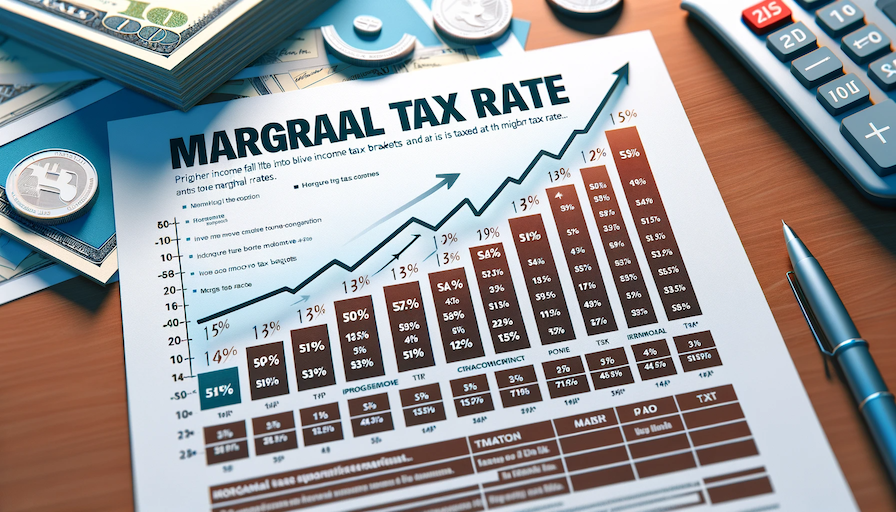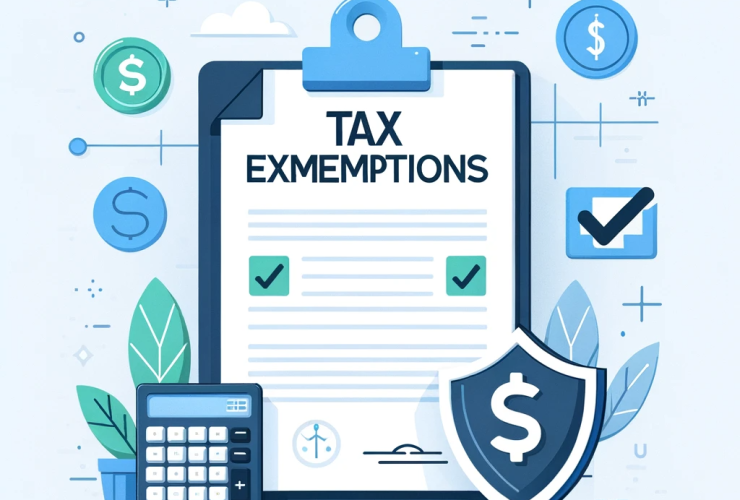Introduction to Marginal Tax Rate
Understanding the concept of the marginal tax rate is crucial for anyone earning an income. The marginal tax rate is the tax rate applied to the last dollar of your income. This rate is part of a progressive tax system, which applies different tax rates to different levels of income.
As income rises, it is taxed at a higher rate. This system aims to tax individuals based on their earnings so that low-income earners are taxed at a lower rate than higher-income earners.

First, Understanding Progressive Taxation
Progressive taxation is a method of taxation that taxes individuals based on their earnings. In this system, the first dollars you earn are very likely taxed at a lower rate than later ones. This means that as your income increases, the last dollar earned will be taxed at a higher rate. This system aims to create a more equitable society by taxing higher-income earners at a higher rate.
This is in contrast to a flat tax rate system, where everyone is charged the same rate, regardless of their income level. Most systems that use a flat tax rate don’t allow for deductions and are seen in countries with a rising economy.
Those who support this system of taxation describe it as fair because it taxes all people and businesses at the same rate. However, those who oppose it believe that it results in high-income taxpayers paying less than they should for an equitable society.
How Marginal Tax Rate Works
The marginal tax rate works by applying different tax rates to different levels of income. These different levels of income are divided into tax brackets or ranges. Each tax rate only applies to income that falls within the corresponding bracket. Each additional dollar beyond that bracket will be taxed at the next highest marginal rate.
For example, in 2024, a single filer with a taxable income of $115,000 would determine their marginal tax rate by applying the current progressive tax scale to each portion of their income within the relevant brackets. The first $11,600 of their income would be taxed at 10%, the next $35,550 at 12% (up to $47,150), and the subsequent $53,375 at 22% (up to $100,525). Since the highest portion of their income falls within the 24% bracket, the marginal tax rate for any additional income over $100,525 would be 24%. This results in a marginal tax rate of 24% for a single filer with a taxable income of $115,000 in 2024.
Tax brackets are adjusted each year to account for inflation. These adjustments can help prevent taxpayers from ending up in a higher tax bracket as their cost of living rises. The tax bracket adjustments can also lower taxes for those whose compensation has not kept up with inflation.
Current Marginal Tax Rates
Presenting the Current Marginal Tax Rates for 2024
| Tax Rate | Single Filers: Taxable Income Over | Married Filing Jointly: Taxable Income Over |
|---|---|---|
| 10% | $0 | $0 |
| 12% | $11,600 | $23,200 |
| 22% | $47,150 | $94,300 |
| 24% | $100,525 | $201,050 |
| 32% | $191,950 | $383,900 |
| 35% | $243,725 | $487,450 |
| 37% | $609,350 | $731,200 |
Changes in Tax Rates Over the Years
The U.S. federal tax rates will remain the same until 2025 as a result of the Tax Cuts and Jobs Act of 2017. However, the income thresholds that inform the tax brackets are generally adjusted each year to reflect the rate of inflation.
These adjustments can help prevent taxpayers from ending up in a higher tax bracket as their cost of living rises. The tax bracket adjustments can also lower taxes for those whose compensation has not kept up with inflation.
Understanding Tax Brackets
Explanation of Tax Brackets
Taxpayers are divided into tax brackets or ranges under a marginal tax rate. The brackets determine the rate applied to increments of the filer’s taxable income.
As income increases, the last dollar earned will be taxed at a higher rate than the first dollar earned, which will be taxed at the rate for the lowest tax bracket. The last dollar earned will be taxed at the rate of the highest bracket and all the money in between is taxed at the rate for the range into which it falls.
How Income Levels Determine Tax Brackets
Tax brackets are set ranges of income, each taxed at a specific rate. Your income level determines which brackets your income falls into. As your income increases, it crosses into higher tax brackets.
Each bracket has a threshold; income below this threshold is taxed at a lower rate. Once your income exceeds a bracket’s limit, only the income above that limit is taxed at the higher rate of the next bracket.
Thus, your income is segmented, with each portion taxed according to the bracket it falls into. This ensures progressive taxation, where higher income incurs higher taxation rates.
Marginal Tax Rate vs Effective Tax Rate

Definition of Effective Tax Rate
The effective tax rate is the percentage of your income owed to the IRS. It’s the average rate you pay on all your income.
Differences Between Marginal and Effective Tax Rate
The marginal tax rate is the tax rate paid on the highest dollar of income, while the effective tax rate is the average rate paid on all income. This means that your marginal tax rate will likely be higher than your effective tax rate.
In a progressive marginal tax rate system, like the US uses, the first dollars you earn are very likely taxed at a lower rate than later ones, which means you’re unlikely to actually pay the exact rate listed on your tax bracket for all of your dollars.
Calculating Your Marginal Tax Rate
The marginal tax rate is the tax rate paid on the highest dollar of income. It’s part of a progressive tax system, which applies different tax rates to different levels of income. As income rises, it is taxed at a higher rate. Here’s a step-by-step guide on how to calculate the marginal tax rate:
- Identify your taxable income for the year.
- Determine the tax brackets and the corresponding tax rates.
- Find the tax bracket that your income falls into.
- The tax rate for that bracket is your marginal tax rate.
Examples of Marginal Tax Rate Calculations

Let’s consider an example for better understanding. Suppose Sarah has a taxable income of $100,000 per year. Her income will be taxed using the following marginal tax rate examples:
- 10% for the first $20,000 of income.
- 12% for income between $20,000 and $40,000.
- 22% for income between $40,000 and $60,000.
- 30% for income between $60,000 and $80,000.
- 40% for income between $80,000 and $120,000.
As you can see, Sarah’s income will be taxed at different rates as it moves through the tax schedule, increasing as it enters each new bracket. Since the last dollar she made falls into the income range of $80,000 to $120,000, her marginal tax rate would be 40%.
Important: This example is hypothetical only, and the tax brackets do not reflect actual tax brackets.
Common Misconceptions about Marginal Tax Rate
A common misconception about the marginal tax rate is that getting a raise could bump you into a new tax bracket and lead to you being taxed so much that your income is effectively lower than before.
This is not true because not all of your income is subject to the same tax rate. In a marginal tax rate system, your income is taxed differently depending on what you make each year. In a progressive marginal tax rate system, like the US uses, the first dollars you earn are very likely taxed at a lower rate than later ones.
Frequently Asked Questions about Marginal Tax Rate
What is a Marginal Tax Rate?
A marginal tax rate is the tax rate applied to the last dollar of your income in a progressive tax system. It varies according to the different levels of income, with higher income being taxed at a higher rate.
How Does Progressive Taxation Work?
Progressive taxation taxes individuals based on their earnings, with lower income being taxed at a lower rate and higher income at a higher rate. This system uses different tax brackets to apply varying tax rates to different levels of income.
What is the Difference Between Marginal and Effective Tax Rate?
The marginal tax rate is the rate paid on the highest dollar of income, while the effective tax rate is the average rate paid on all income. The marginal rate is usually higher than the effective rate in a progressive tax system.
How Do I Calculate My Marginal Tax Rate?
To calculate your marginal tax rate, you need to determine your taxable income, identify the tax brackets and rates, and find the bracket your income falls into. The rate for your highest income bracket is your marginal tax rate.
What are the Current Marginal Tax Rates for 2023?
The marginal tax rates for 2023 range from 10% to 37%, with different brackets for single filers and married couples filing jointly. The rates are applied to specified ranges of taxable income.
Does Getting a Raise Push Me into a Higher Tax Bracket?
Getting a raise can move you into a higher tax bracket, but it won’t make your entire income subject to the higher rate. Only the income above the previous bracket’s threshold is taxed at the higher rate.
Are Tax Brackets Adjusted Annually?
Yes, tax brackets are usually adjusted annually to account for inflation. This helps prevent taxpayers from moving into higher tax brackets solely due to inflation.
How Does a Flat Tax Rate System Differ from Progressive Taxation?
A flat tax rate system taxes all income at the same rate, regardless of how much one earns. This contrasts with progressive taxation, where tax rates increase with higher income levels.



